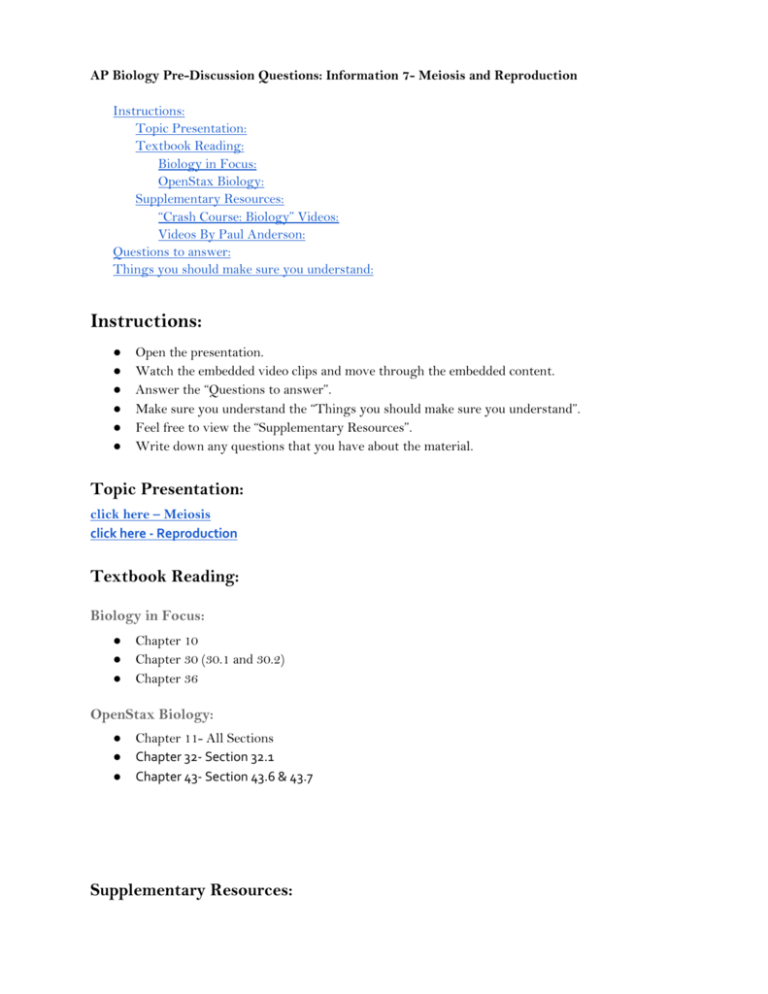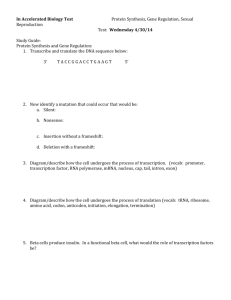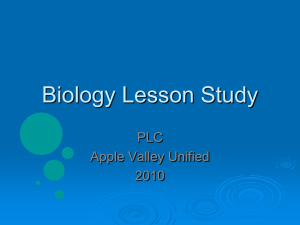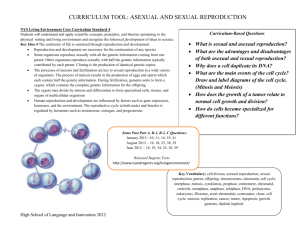Biology in Focus
advertisement

AP Biology Pre-Discussion Questions: Information 7- Meiosis and Reproduction Instructions: Topic Presentation: Textbook Reading: Biology in Focus: OpenStax Biology: Supplementary Resources: “Crash Course: Biology” Videos: Videos By Paul Anderson: Questions to answer: Things you should make sure you understand: Instructions: ● ● ● ● ● ● Open the presentation. Watch the embedded video clips and move through the embedded content. Answer the “Questions to answer”. Make sure you understand the “Things you should make sure you understand”. Feel free to view the “Supplementary Resources”. Write down any questions that you have about the material. Topic Presentation: click here – Meiosis click here - Reproduction Textbook Reading: Biology in Focus: ● ● ● Chapter 10 Chapter 30 (30.1 and 30.2) Chapter 36 OpenStax Biology: ● ● ● Chapter 11- All Sections Chapter 32- Section 32.1 Chapter 43- Section 43.6 & 43.7 Supplementary Resources: “Crash Course: Biology” Videos: Meiosis- Where the Sex Starts: Biology #13 Animal Development: We're Just Tubes - Crash Course Biology #16 Videos By Paul Anderson: “Cell Cycle, Mitosis and Meiosis” “Meiosis” “Mechanisms that Increase Genetic Variation” “Plant Structure” “The Reproductive System” “Development: Timing & Control” Questions to answer: Meiosis 1. Explain how asexual reproduction is different from sexual reproduction. 2. Explain what happens during crossing over and when it occurs in meiosis. 3. How is metaphase I different from metaphase of mitosis? 4. Explain why sexual reproduction increases variation among offspring much more than asexual reproduction does. 5. How many possible genetic variations can be produced during meiosis and sexual reproduction? 6. How is sexual reproduction related to gender determination in mammals? 7. If the progenitor cell of a gamete has 12 pairs of chromosomes during G1 of interphase, how many chromosomes will the following cells have? a. after S phase of interphase. b. a daughter cell immediately following cytokinesis I of meiosis. c. a daughter cell during anaphase II of meiosis. d. a dauther cell immediately following cytokinesis II of meiosis. Reproduction and Development 1. Explain what happens during each of the following phases of animal development: a. fertilization d. neurulation b. cleavage e. organogenesis c. gastrulation 2. Diagram the structure of the amniotic egg, label each membrane and provide a brief description of their functions. 3. What is the function of the placenta in eutherian mammals? 4. What would you expect would happen to gene expression in a cell as it develops and differentiates in a developing organism? 5. Compare primary and secondary growth, and identify the tissue responsible for each. 6. Where is active xylem tissue found in a mature tree? 7. How is development in plants and animals similar? How does it differ? Things you should make sure you understand: (feel free to ask questions about them in class) Meiosis ● The differences in sexual life cycles shown in plants, fungi, and animals. ● The relationship between homologous pairs of chromosomes. ● How meiosis evolved and why it bears a strong resemblance to mitosis. ● The major differences between mitosis and meiosis. ● The process of karyotyping and why/when it is used Reproduction and Development ● How cells receive positional information during animal development. ● How cell fate is determined during animal development. ● How pattern formation in plants is established.








